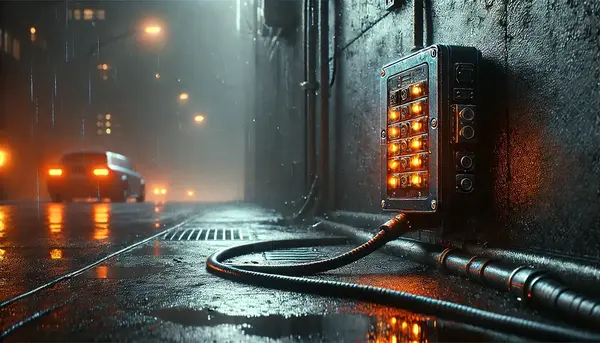

Joining the World Wide Web
 jonas
jonas- HomeLab
- January 26, 2025
The infrastructure is set up, the blog is ready to go, and now the only thing missing is sharing my thoughts with the world. This is the step I’ve delayed the longest in this project. Why? Because it means losing control. Once the blog is on the internet, I have to rely on public providers and trust that everything is configured correctly on my end.
Domain Names
A quick clarification: A domain is the name before the “.com.” Domain names aren’t free—you have to purchase them.
If you’re wondering why the blog is called BoniClaud, here’s the simplest answer: it was the first domain name I came up with that wasn’t already taken.
I really wanted the word “cloud” in the name since this project revolves around cloud technologies. Unfortunately, as you might have guessed, most domains with “cloud” are already taken. For instance:
- BoniCloud.com (with the “o”) is parked for $11,000 USD.
- JonasCloud.com hosts a poorly scaled training website.
So, I went with the quirky “claud” instead of “cloud” and swapped “Jonas” for “boni.” Welcome to BoniClaud.com!
Finding a free domain name was just the beginning. I still needed to purchase it. Here’s where things got interesting:
Many desirable domains are “parked,” meaning someone bought them not to use, but to sell for a profit. These domains often show nothing but a placeholder page with the asking price and payment instructions. If a domain name is still free, you need to register it with a Registrar—a service that registers your domain with the central domain name system (DNS).
The cost of registering a domain varies depending on the suffix (e.g., “.com” vs. “.io”) and the Registrar. Some Registrars charge extra for additional services, which may or may not be useful depending on your needs.
Why Cloudflare?
I chose Cloudflare as my Registrar. Here’s why:
- Transparent Pricing: Cloudflare doesn’t add a markup. A “.com” domain costs $10 USD per year, and that’s exactly what you pay.
- No Long-Term Lock-In: Domains are registered for one year at a time. If I don’t renew in time, the domain becomes free again. However, if I lose my domain, it’s likely someone will buy it just to park it and resell it for a markup.
Cloudflare is more than just a Registrar. Let’s talk about their additional features: Solving Dynamic IP Issues
One of the biggest challenges of hosting a blog at home is dealing with dynamic IP addresses. Most Internet Service Providers (ISPs) don’t assign static IPs to residential connections. Instead, your IP address changes periodically, which can make it difficult for your domain to consistently point to your server.
The solution? Dynamic DNS (DynDNS). This system updates your DNS records whenever your IP address changes, ensuring your domain stays accurate. However, this approach isn’t perfect—it may result in brief downtime during updates. Additionally, some ISPs block certain ports, making it impossible to host web traffic even if your DNS is correctly configured.
Here’s where Cloudflare Tunnels shine. Instead of exposing your server directly to the internet, a small Cloudflare service opens a secure tunnel between your local server and Cloudflare. Visitors connect to Cloudflare’s servers, which then forward requests through the tunnel to your blog.
Advantages of Cloudflare Tunnels:
- No need to worry about dynamic IPs or opening firewall ports.
- Enhanced security by isolating your server from direct internet exposure.
- Flexible configuration for services within Kubernetes namespaces, ensuring even compromised services can’t access your local network.
Content Delivery Networks (CDNs)
Why does Cloudflare offer so much for free? Because they make their money from their Content Delivery Network (CDN) services.
A CDN helps distribute content faster by caching copies of your website on servers around the world. For a static blog like mine, this can be particularly useful. Instead of every user accessing my server, they load pages from a Cloudflare server close to their location. This reduces load times for users and minimizes traffic on my server.
Here are some of Cloudflare’s additional features that I found interesting:
- Edge Caching: Automatically caches static content (like blog posts) on Cloudflare servers for faster delivery.
- TLS Certificates: Provides free HTTPS certificates, saving you the hassle of managing them manually.
- Email Forwarding: Allows you to receive emails sent to your domain without setting up a mail server.
While I don’t need most of these features right now, they’re tempting to explore—just for fun!
Securing Your Network
Exposing services to the internet requires vigilance. Here are some basic steps I took to ensure my setup is secure:
- Limit Open Ports: Only open the necessary ports for your web service. Close administrative ports like SSH or protect them with strong authentication.
- Isolate Services: Use network namespaces or VLANs to prevent exposed services from accessing your local network. For instance, my blog and its tunnel are in their own namespace, and they can’t communicate with other devices.
- Monitor Traffic: Before registering a domain, I briefly exposed my SSH port to the internet. Despite having no domain pointing to my IP, I received nearly 60 login attempts in a short time. This highlights the importance of limiting exposure.
Final Thoughts
Getting your service online can feel overwhelming, but it doesn’t have to be. Registering a domain with a reliable Registrar like Cloudflare and leveraging modern tools like Cloudflare Tunnels makes the process manageable—even for home-hosted setups.
While you can overthink every detail, the simplest approach often works best. And if you’re not into tinkering, consider using a web hosting service. They’ll have everything pre-configured for you and will likely perform better than a DIY solution.